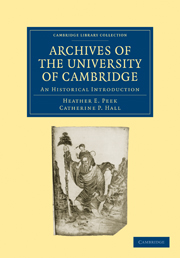Book contents
- Frontmatter
- Contents
- List of Plates
- Preface
- PART I
- PART II
- 4 The University and Colleges as Privileged Corporations
- 5 Records of University Administration
- 6 Records of Matriculation and Degrees
- 7 Financial Records of the University
- 8 Endowments of the University
- 9 University Officers and their Records
- 10 Records of the University Courts
- 11 Records of University Jurisdiction in the Town of Cambridge
- 12 The Relations between the Crown and the University
- 13 Other University Institutions and their Records
- APPENDICES
- Index
- Index to Muniments of Title in Appendix B
- Plate section
8 - Endowments of the University
Published online by Cambridge University Press: 07 September 2010
- Frontmatter
- Contents
- List of Plates
- Preface
- PART I
- PART II
- 4 The University and Colleges as Privileged Corporations
- 5 Records of University Administration
- 6 Records of Matriculation and Degrees
- 7 Financial Records of the University
- 8 Endowments of the University
- 9 University Officers and their Records
- 10 Records of the University Courts
- 11 Records of University Jurisdiction in the Town of Cambridge
- 12 The Relations between the Crown and the University
- 13 Other University Institutions and their Records
- APPENDICES
- Index
- Index to Muniments of Title in Appendix B
- Plate section
Summary
It was customary in the medieval university for benefactors to be recompensed for their generosity in masses and prayers offered by the clerks of the university for the welfare of their souls. The earlier statutes recorded in the Proctors’ Books contain several directed to this end, among them the statute of 1398 for Sir William Thorpe, in whose completed chapel many of the services for departed benefactors were to be held. The calendars, with which the Proctors’ Books are prefaced, have entered in them the days on which exequies of the more important benefactors were to be observed. In addition, the colleges had their own commemorations, and among the charters of the university are several compositions with a college to provide for joint performance of pious duties connected with a benefaction. As the number of benefactors increased, all could not be given special obituary services, and a form of annual commemoration was adopted, mentioning each by name only in a general bidding prayer. A late pre-Reformation form is given in Stokys’ Book, dated by its exhortation (following the names of departed royal benefactors), ‘et (orate) pro bono statu domini Henrici Octavi regis nostri et Katerine regine consortis sue’.
The first decade of the sixteenth century brought to the university by far the most important of the benefactions made specifically to provide for the welfare of the donors’ souls, those of King Henry VII and the Lady Margaret, his mother. Each takes the form of a lengthy tripartite indenture, in book form, sealed with the respective seals of the parties.
- Type
- Chapter
- Information
- Archives of the University of CambridgeAn Historical Introduction, pp. 37 - 41Publisher: Cambridge University PressPrint publication year: 1963First published in: 1962



